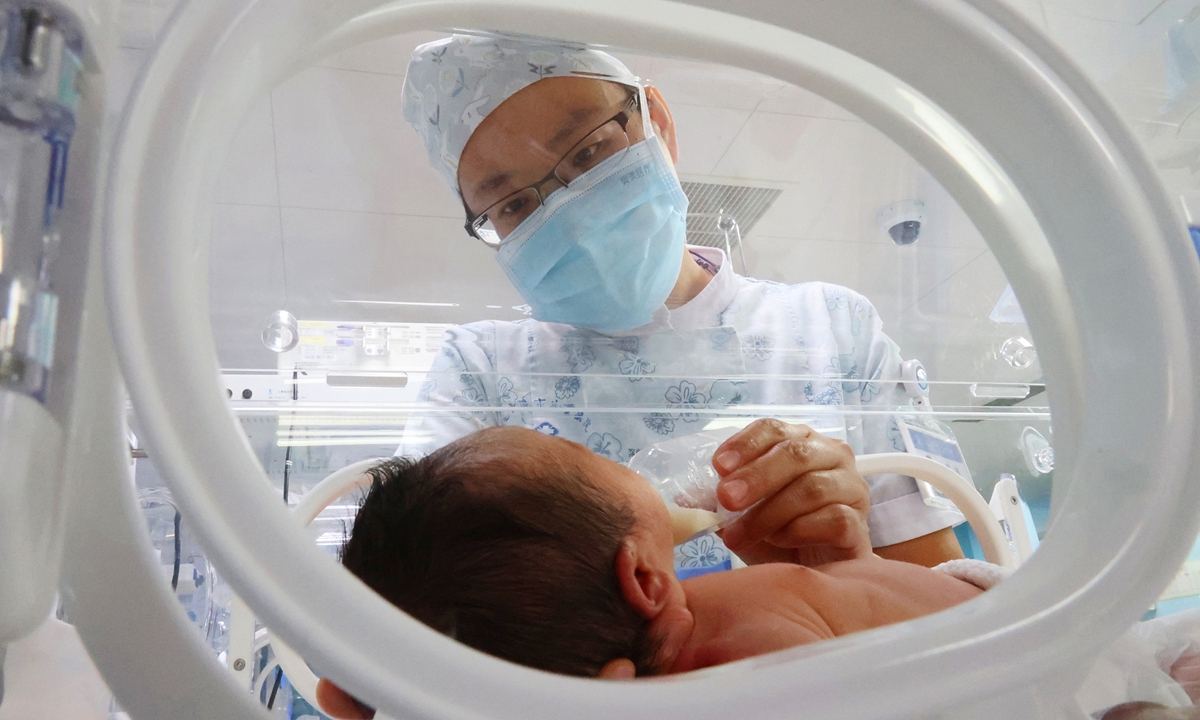
Medical personnel are caring for newborns at a hospital in Lianyungang, East China's Jiangsu Province, on January 1, 2024. Photo: CFP
China's population decreased by 2.08 million people in 2023 to 1.40967 billion, the National Bureau of Statistics (NBS) data showed on Wednesday. In 2023, 9.02 million babies were born, resulting in a birth rate of 6.39 per thousand people. Meanwhile, 11.1 million people died in 2023, equal to a death rate of 7.87 per thousand people, the data showed.
The natural population growth rate was negative 1.48 per thousand people, the NBS said.
The male population was 720.32 million, surpassing the female population that was 689.35 million, data showed. The overall gender ratio was 104.49 (per 100 females).
In terms of age, the working-age population (aged 16-59) stood at 864.81 million, making up 61.3 percent of the total population.
The population aged 60 and above was 296.97 million, accounting for 21.1 percent of the total population, with population aged 65 and above being 216.76 million, making up 15.4 percent of the total.
Regarding urban-rural composition, the urban population was 932.67 million in 2023, an increase of 11.96 million compared to the previous year, while the rural population was 477.00 million, a decrease of 14.04 million. The urban population accounted for 66.16 percent of the total population, which increased by 0.94 percentage points compared to the previous year, according to the data.
Following China's first-ever population decline in 2022, the extent of population decline in China had been expected to deepen in 2023, according to demographic forecasts.
The latest China Development Report 2023 released by the State Council's Development Research Center pointed out that over the past 12 years, China has experienced two significant turning points in terms of population: the peak of the working-age population and the peak of the total population. Currently, China's total population is at its peak, and it is expected to continue declining for the foreseeable future.
Professor Yuan Xin, deputy head of the Population Association of China and a demographer from Nankai University in Tianjin, was quoted as saying in media reports on Wednesday that international experience suggests that the initial stages of population decline are often accompanied by fluctuations in population growth and decline.
Due to changes in population size and the impact of the COVID-19 pandemic, population decline in 2023 is expected to be more pronounced than in 2022, Yuan said. However, in 2024, the Year of the Dragon according to Chinese zodiac sign, during which people more prefer to have baby, and with the potential rebound in fertility due to the effects the post-pandemic, population decline may ease somewhat, the expert noted.
The report states that a continued decline in the birth rate will be the dominant long-term trend impacting China's population change. It is estimated that in the coming years, the number of births is expected to decrease by approximately one million every decade.
The report identifies four main reasons for the expected continuation of low birth rates in the future including delayed marriage age, decreased willingness among young people to have children, reduction in the number of women of childbearing age and higher prevalence of infertility and subfertility.
Global Times




